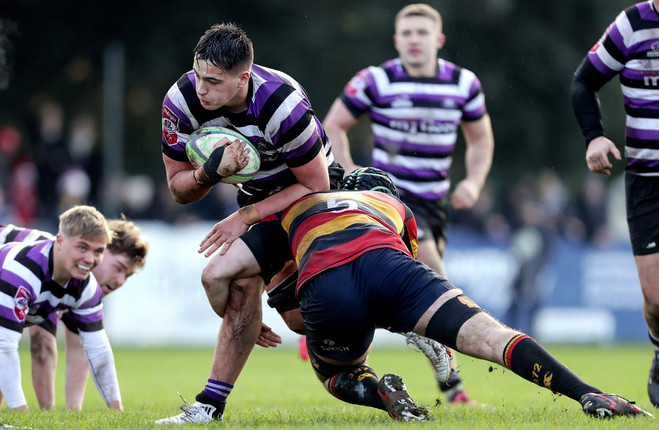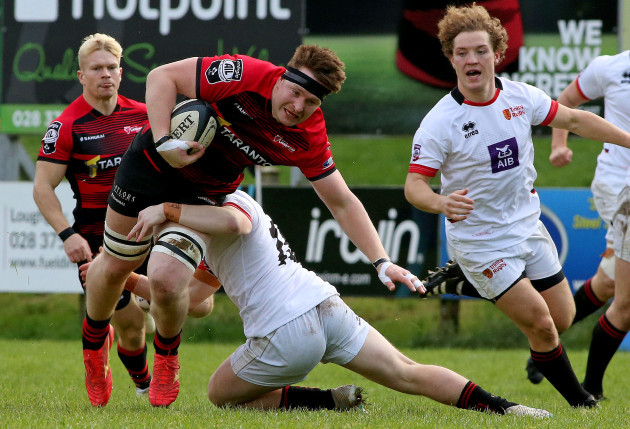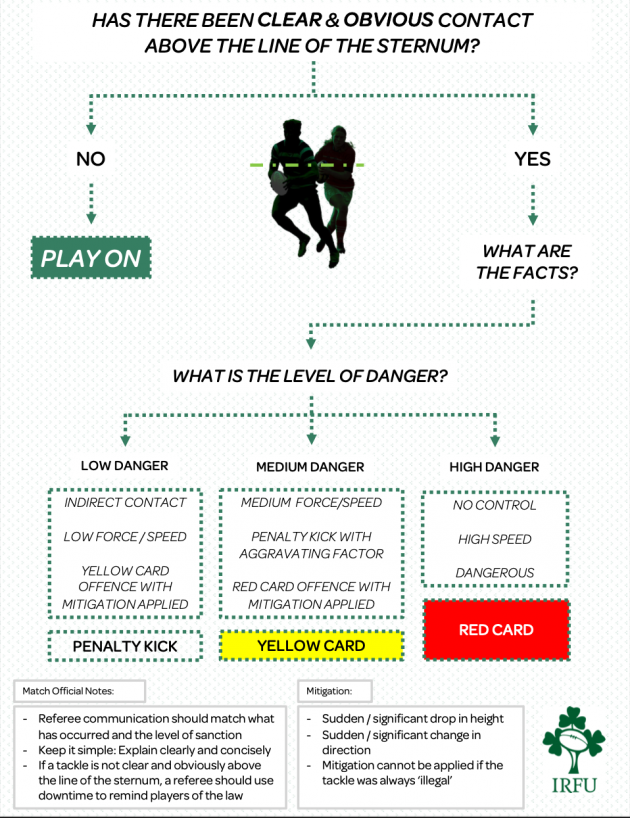AS EXPECTED, THE early stages of adjustment have been uncomfortable in Irish amateur rugby this season.
The 2023/24 campaign brought with it a new legal tackle height of below the line of the sternum.
This isn’t happening in professional rugby where the legal tackle height remains the line of the shoulders, but all of Irish amateur rugby has undergone this change after the IRFU opted into a World Rugby law trial that aims to reduce head injuries.
In the IRFU’s own words, the ‘belly tackle’ is the safest tackle. World Rugby’s injury data backs that up and so, the Irish union is now undertaking a two-year trial with this new tackle height.
It applies to every level of the domestic game, including the All-Ireland League [AIL] where the standard of rugby is excellent. In many ways, it looks like the pro game there, so they’ve had challenges getting to grips with the new status quo.
There have been red cards, yellow cards, and penalties aplenty for high tackles, including one round of AIL fixtures in which there were six red cards in this area. There are similar stories from all levels of the amateur game as everyone gets to grips with the new tackle height.
“It’s 100% the difference between winning and losing games at the moment,” says Morgan Lennon, who coaches Old Wesley in Division 1B of the AIL.
Discipline has always been a big indicator of success in rugby and the new tackle height has brought that even more sharply into focus so far this season.
The flurry of cards and penalties is not a surprise for the IRFU, having seen similar circumstances in New Zealand and France, where the amateur games have also lowered the tackle height in recent years. They too had an increase in high tackle sanctions over the first three to six months.
The IRFU’s national rugby development manager, Colm Finnegan, is one of the key figures in this project and he also coaches Cooke in the Women’s AIL.
“It’s definitely not something we’re worried about,” says Finnegan of the rise in high tackle sanctions. “It’s part of the adaptation process.”
Finnegan also stresses that the change is all about player welfare and the hope that head injuries will be reduced. He says consultation with clubs and schools underlined that those involved in the amateur game wanted to make rugby safer.
It’s a sentiment shared by anyone we’ve spoken to about the new tackle height.
“We knew there was going to be change and it’s a difficult change but I think everyone has bought into why it’s happening,” says Jonny Holland, the former Munster player who is now head coach of Cork Constitution in Division 1A of the AIL.
Holland says this is “for the greater good of the game,” while Lennon adds that “we’re all on the same hymn sheet” in wanting to protect players.
Everyone also seems to be in agreement that this has been fiendishly difficult for referees in the amateur game. As in the pro sport, the referees have a framework for their decision-making on tackles but that’s where the similarities end.
“The referees have the hardest job,” says Lennon. “Without assistant referees who have eyes on everything, without backup from a TMO, it is incredibly difficult to identify if a tackle was above or below the sternum, or was it just a big hit on the belly area that jolted the carrier’s head back?
“They’re trying to make these split-second decisions when there could be a crowd of players or a breakdown in front of them.”
Finnegan says the IRFU has been impressed with how referees are trying to be in “constant conversation” with players, almost coaching them through the process rather than only forcing change with harsh sanctions.
He stresses that this collaborative approach is necessary if it’s going to work. The desire to work together is there from the clubs’ point of view too. That said, the AIL sides feel the communication can improve.
After an initially smooth-ish intro in the opening three rounds of the AIL, the clubs returned from the first break weekend to be greeted by a clearly renewed focus on high tackles in round four. That’s when the six red cards were dished out.
The AIL clubs felt that focus could have been more clearly shared with them beforehand.
Last week, the IRFU hosted a webinar on how the tackle height trial has been going and there’s no doubt it could have included more video examples of incidents that were sanctioned, those that were missed but could have been sanctioned, and any errors.
Finnegan points out that these are early days and the data will come in due course, but the clubs are eager to learn as much as they can as soon as possible.
“What’s the most common type of tackle getting a yellow card? That would be interesting information to have from a coaching perspective,” says Lennon.
He and Holland both point to the second tackler or ‘assist tackler’ as an obvious challenge in all of this. That second tackler must be below the sternum too.
“Where I find it difficult is the second defender, the catch-up defender who would have tagged the ball before,” says Holland. “You can still tag the ball but if you hit someone with force, it’s a penalty, so there are subtleties within that.
“The second defender is trying to be physical but you can get that slightly wrong. You can be the assist tackler, the second tackler, and hit low if there is space but that’s one we’re seeing go wrong.”
Lennon is in agreement. He feels teams will have to consider whether double tackles are viable.
“That’s the biggest issue,” says Lennon. “It’s so difficult when one person makes a tackle and another person sees an opportunity to strip the ball or make a double tackle to slow the ball down. That’s almost going out of the game unless you’re willing to risk giving away a penalty or yellow card.”
In France, where the legal tackle height was lowered to the waist in 2019, they outlawed the double tackle. In New Zealand, the first tackler must go below the sternum but the second is still able to legally tackle below the shoulders.
Finnegan says the IRFU wanted to make sure there was clarity because double tackles can be almost simultaneous. The Irish union felt the best chance of player safety was keeping three heads out of the same space, so both tacklers must be below the sternum.
And Lennon points out that this could see a shift in attacking rugby. Data from France and New Zealand says there has been an increase in offloading since their changes in tackle height and the Old Wesley coach wonders if similar will happen here.
“Are the bigger teams going to stop double tackling, can you play more directly through them with offloads rather than going around them? It’s probably too early to see that but it will probably alter everyone’s picture on attack,” says Lennon.
There have been some seriously high-scoring games in the AIL so far this season, although Holland points out that the league has been very attacking-minded in recent years anyway.
There is a demanding task for any professionally contracted or academy players stepping back into the AIL, meaning they could go from training and playing with a higher tackle limit for weeks on end to having to adjust to the lower height in the space of a few days.
But Finnegan says the tackle height working group has had each of the provincial academy managers in on calls about this, while they have also engaged with the IRFU’s high performance department on it. Furthermore, he says that only 3% of players in the men’s AIL on a given weekend are contracted with the provinces.
“It’s important that we’re doing something that is best for the 97% players,” Finnegan says.
While the new tackle height is proving challenging, it’s good to hear that predictions of players walking away from the game in frustration have not come true so far.
“I’ve seen none of that,” says Holland. “Even if there will still be disagreement about decisions, there hasn’t been lots of dissent.”
Lennon points out that rugby players will do whatever they need to increase their chances of winning and that’s been the case with this change too.
And Finnegan highlights the data coming from the domestic game in New Zealand for encouragement. New Zealand Rugby recently revealed a 7% increase in participation at the grassroots over the past year as it extended its tackle height trial into 2024 and 2025.
The IRFU’s trial also runs until 2025 and Finnegan insists that the union has an open mind about the outcome. This might not be the panacea or even a decent remedy for the issue of head injuries.
“We were always mindful that a trial is very much that and the results can never be fully predicted,” says Finnegan.
“Different things will arise as we go through the two seasons of the trial and we need to be open to make sure we’re aware of them and then to implement anything we need to.”
The decisive factor in whether the IRFU continue with this tackle height once the two-year trial is complete will be injury data gathered by the Irish Rugby Injury Surveillance [IRIS] research project, which has been collecting this data for a few years now.
The project is a collaboration between the IRFU and the University of Limerick, with the latest agreement running until 2030. Its invaluable data will help the IRFU to understand if the tackle height change is having a positive effect in terms of injuries.
So it is that the players and coaches and referees will keep doing their best to adapt, hoping they get as much information as possible along the way.
“Everyone has been taught to tackle low anyway,” points out Holland.
And Lennon underlines that there’s an acceptance that they all have to get on with it as the IRFU assesses whether this actually makes the game safer.
“This is here for the long haul, we have to get used to it.”




